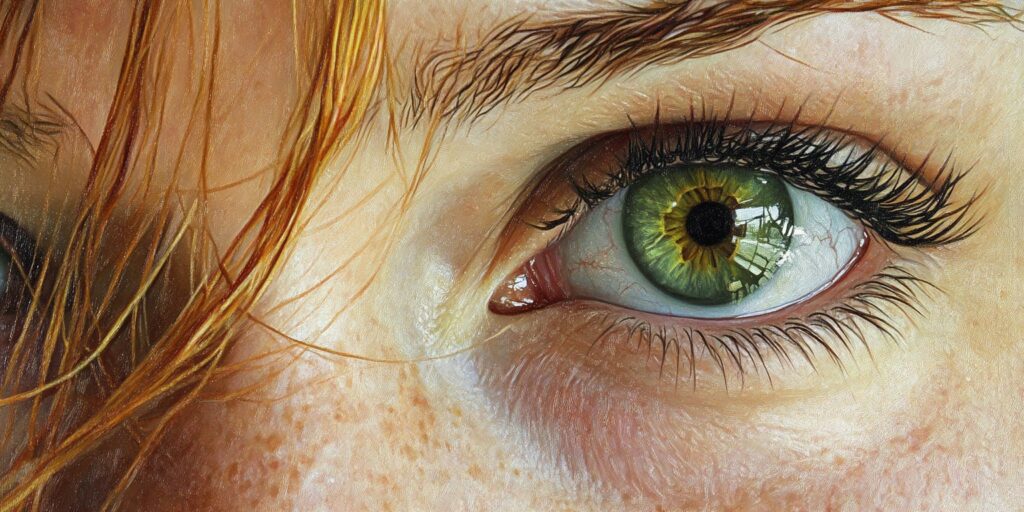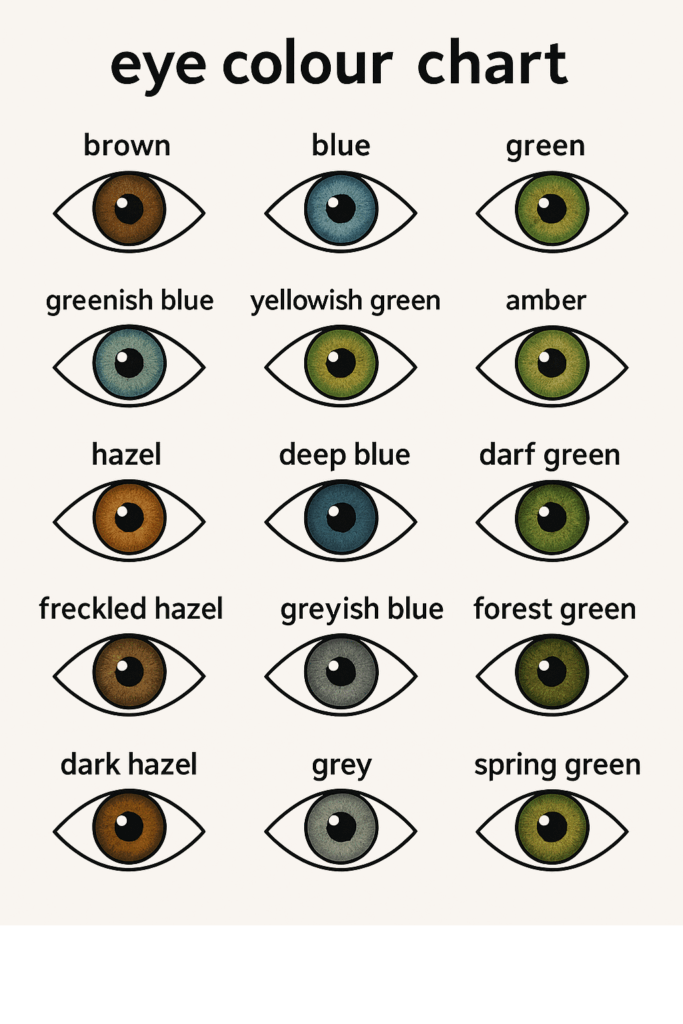natural eye color chart
Ihr Leitfaden, Informationen und Tipps
Natural Eye Color Chart: Understanding Shades and Genetics
Eye color is one of the most fascinating aspects of human appearance, varying widely from rich browns to brilliant blues, and even shades as rare as violet. This diversity comes from a complex interplay of genetics, pigments, and light scattering, resulting in an array of unique hues.
With a natural eye color chart, we can understand not only the range of eye colors but also the science behind why our eyes look the way they do. Whether you’re exploring your own shade or the rarity of a friend’s eye color, this guide provides insight into the genetics and significance of each color.
| Topic | Key Takeaways |
|---|
| Introduction: The Diversity and Significance of Eye Colors | Overview of the range of natural eye colors and their scientific and cultural importance. |
| The Core Eye Color Spectrum | Main colors: brown, blue, green, and hazel; each color’s traits and distribution in the world. |
| Rare and Unique Eye Colors | Description of rare colors like amber, grey, and violet/red, with reasons for their rarity. |
| The Genetics Behind Eye Color | Basic genetics of eye color, involving polygenic inheritance and genes like OCA2 and HERC2. |
| The Science of Eye Color Formation: Melanin, Pigmentation, and Light Scattering | How melanin and Rayleigh scattering create different eye colors, with a focus on lipochrome’s role. |
| Why Eye Color Can Change Over Time | Factors that cause natural changes in eye color, such as lighting, health, and aging. |
| Cultural and Psychological Perspectives on Eye Colors | Symbolism, historical beliefs, and psychological perceptions associated with various eye colors. |
| Eye Color Chart as a Tool for Understanding Genetic Traits and Rarity | Using the eye color chart to track inheritance patterns and eye color rarity across populations. |
The Core Eye Color Spectrum: Understanding the Range of Natural Eye Colors
The core eye color spectrum encompasses the primary hues found in human eyes, each with its unique genetic background, evolutionary significance, and role in human diversity. This spectrum includes the most prevalent shades like brown, blue, and green, as well as rarer colors such as grey, hazel, and amber. Understanding this spectrum provides fascinating insights into how eye colors develop, their global distribution, and the biological mechanisms behind them.
1. The Prevalence of Brown Eyes
Brown is the most common eye color worldwide, accounting for approximately 55-79% of the global population. This shade is due to high concentrations of melanin in the iris, which results in a rich, dark hue. Brown eyes are especially prevalent in regions with high sun exposure, such as Africa, South America, and parts of Asia, where melanin’s UV-protective properties are advantageous. In evolutionary terms, this pigmentation helped protect the eye from sunlight, which may explain why brown eyes are so widely distributed.
2. Blue Eyes: A Unique Genetic Mutation
Blue eyes, seen in 8-10% of the world’s population, are believed to have originated from a single genetic mutation around 6,000-10,000 years ago in Europe. Blue eyes lack melanin in the front layers of the iris, allowing light to scatter and create a blue appearance—a phenomenon similar to why the sky appears blue. Blue eyes are more common in Northern and Eastern Europe and remain relatively rare in other parts of the world.
3. Green Eyes: A Rare Combination
Green eyes are among the rarest natural eye colors, present in only about 2-3% of people worldwide. The green hue results from moderate melanin levels combined with a yellow pigment called lipochrome. This combination creates a vibrant green shade, often associated with people of Celtic and Northern European descent. Due to its scarcity, green eyes are sometimes seen as exotic and are frequently idealized in media and culture.
4. Hazel Eyes: A Dynamic Mix
Hazel eyes fall between brown and green on the color spectrum, with an appearance that can seem to shift between these shades. Hazel eyes, which account for about 5-8% of the global population, contain a mix of melanin and lipochrome, creating a multi-tonal effect that often changes depending on lighting conditions. This variation gives hazel eyes a unique appeal, as their color seems to adapt and change.
5. Grey Eyes: The Rare Reflection
Grey eyes are one of the rarest eye colors, accounting for less than 1% of the global population. This color appears due to very low melanin levels combined with a dense fiber structure in the iris, which diffuses light in a way that gives the eye a greyish appearance. Grey eyes are most commonly found in Eastern Europe and parts of Northern Europe. Like blue eyes, grey eyes lack melanin, but their denser structure gives them a more muted look.
6. Amber Eyes: The Golden Glimmer
Amber eyes are even rarer, often described as having a golden or coppery hue due to the presence of lipochrome without much melanin. These eyes are sometimes referred to as „wolf eyes“ because of their similarity to the eye color of certain animals. Amber eyes are most commonly found in South America and Asia but are very rare in general, adding to their exotic appeal.


| Eye Color | Global Distribution (%) |
|---|
| Brown | 55-79% |
| Black | 10-15% |
| Blue | 8-10% |
| Hazel | 5-8% |
| Amber | <5% |
| Green | 2-3% |
| Deep Blue | 2-3% |
| Dark Hazel | 2-3% |
| Grey | 1% |
| Greenish Blue | Rare, ~1% |
| Leaf Green | Rare, ~1% |
| Forest Green | Rare, ~1% |
| Dark Green | Rare, ~1% |
| Freckled Hazel | Rare, ~1% |
| Yellowish Green | Rare, <1% |
| Dark Blue | Rare, <1% |
| Greyish Blue | Rare, <1% |
| Spring Green | Rare, <1% |
Rare and Unique Eye Colors: Exploring the Spectrum's Extremes
While most of the world’s population has brown, blue, or hazel eyes, there exists a fascinating array of rare and unique eye colors that captivate and intrigue. These uncommon hues not only add to the diversity of human appearance but also offer insights into genetics, evolution, and even certain medical conditions. By examining the natural eye color chart, we can delve into some of the rarest eye colors and discover what makes them so exceptional.
Amber Eyes: The Golden Gaze
Global Distribution: Less than 5%
Amber eyes are characterized by a solid, golden-yellow or coppery hue without flecks of other colors. This rare eye color results from the deposition of a pigment called lipochrome (pheomelanin) in the iris, coupled with minimal melanin. Unlike hazel eyes, amber eyes do not contain brown, green, or blue hues. They are most commonly found in individuals from South America, Asia, and parts of Europe. The striking golden appearance of amber eyes often draws comparisons to the eyes of wolves, earning them the nickname „wolf eyes.“ On the natural eye color chart, amber eyes stand out due to their distinctive warm tones.
Green Eyes: The Enigmatic Emerald
Global Distribution: 2–3%
Green eyes are among the rarest natural eye colors, present in only a small fraction of the global population. This captivating hue arises from a combination of low to moderate amounts of melanin and the presence of lipochrome, which produces a light brown pigmentation. The scattering of light through the turbid medium of the stroma adds a blue tint, resulting in the characteristic green color. Green eyes are most prevalent in individuals of Celtic and Germanic ancestry, particularly in regions like Ireland, Scotland, and Northern Europe. In the natural eye color chart, green eyes are positioned between the common blue and brown shades, highlighting their unique pigmentation.
Grey Eyes: The Mystical Mist
Global Distribution: Approximately 1%
Grey eyes are an even rarer phenomenon, primarily found in Eastern and Northern Europe. This eye color is caused by an even lower concentration of melanin than blue eyes and a higher concentration of collagen deposits in the stroma of the iris. The increased collagen scatters light differently, leading to a smoky or silvery appearance. Grey eyes often seem to change color, appearing to be blue, grey, or even green depending on lighting and clothing, adding to their mystical allure. On the natural eye color chart, grey eyes occupy a distinct place due to their subtle and shifting tones.
Violet Eyes: The Rarest Reflection
Global Distribution: Extremely Rare
Violet eyes are exceedingly rare and are usually associated with a lack of pigment combined with light reflecting off of red blood vessels within the eye. This eye color is most commonly found in individuals with albinism, a condition characterized by reduced melanin production. The combination of a translucent iris and the reflection of light gives the eyes a violet hue. Historical figures like Elizabeth Taylor were famed for their violet eyes, though in her case, it was due to the unique way her eyes scattered light rather than albinism. In the natural eye color chart, violet eyes represent one of the most extraordinary hues, often placed at the far end of the spectrum.
Red Eyes: The Albino Effect
Global Distribution: Extremely Rare
True red eyes are the result of severe albinism, where there is a complete absence of melanin in the iris. Without pigment to absorb light, all wavelengths are reflected back out of the eye, and the red color of the blood vessels becomes visible. Individuals with red eyes often have significant vision problems and are highly sensitive to light due to the lack of protective pigmentation. This eye color is at the extreme end of the natural eye color chart, highlighting how genetic conditions can influence eye pigmentation.
Heterochromia: The Eyes of Two Colors
Global Distribution: Less than 1%
Heterochromia is a condition where an individual has two different colored eyes or variations of color within the same eye. There are three types:
- Complete Heterochromia: One iris is a completely different color from the other.
- Sectoral (Partial) Heterochromia: Part of one iris is a different color from the rest.
- Central Heterochromia: The inner ring of the iris is a different color than the outer ring.
Heterochromia can be genetic or acquired due to injury or disease. While rare in humans, it’s more common in certain breeds of cats and dogs. The natural eye color chart cannot capture heterochromia with a single hue, as it involves multiple colors within one individual.
Black Eyes: The Illusion of Depth
Global Distribution: Less than 1% (True Black Eyes)
While many people refer to very dark brown eyes as black, true black eyes are extremely rare. They result from an abundance of melanin that absorbs almost all light entering the eye, giving the iris a black appearance. This condition is called aniridia, a developmental issue where the iris is absent or underdeveloped. It can lead to vision problems and sensitivity to light. On the natural eye color chart, true black eyes represent an extreme of melanin concentration.
The Genetics Behind Rarity
The rarity of these eye colors is largely due to complex genetic factors. Eye color is a polygenic trait, meaning it’s influenced by multiple genes. The two primary genes, OCA2 and HERC2, play significant roles in melanin production and distribution in the iris. Mutations or variations in these genes can lead to uncommon eye colors. For example:
- Green Eyes: Require a specific combination of low melanin and the presence of lipochrome.
- Amber Eyes: Result from a distinct type of pigmentation involving lipochrome without much melanin.
- Grey Eyes: Involve minimal melanin and a unique iris structure that scatters light differently.
These unique genetic combinations are what place these eye colors in special positions on the natural eye color chart, highlighting their rarity and distinctiveness.
Medical Conditions Associated with Rare Eye Colors
Some rare eye colors are linked to medical conditions:
- Albinism: Leads to red or violet eyes due to a lack of melanin.
- Aniridia: Causes extremely dark or black-looking eyes and can affect vision.
- Waardenburg Syndrome: Can result in heterochromia and is associated with hearing loss.
It’s essential for individuals with these eye colors to have regular check-ups with an eye care professional to monitor any associated health issues. Understanding where these eye colors fall on the natural eye color chart can aid in recognizing potential genetic conditions and ensuring proper care.
The Genetics Behind Eye Color: Unraveling the DNA of Our Irises
Eye color is one of the most captivating and variable human traits, offering a window into our genetic makeup and ancestral heritage. The wide spectrum of hues displayed in the natural eye color chart is the result of a complex interplay of multiple genes, each contributing to the pigmentation of the iris in unique ways. Understanding this genetic tapestry not only satisfies curiosity but also highlights the intricate mechanisms that govern human diversity.
Polygenic Inheritance: A Complex Trait
Unlike traits determined by a single gene, eye color is a polygenic trait, meaning it is influenced by multiple genes working in tandem. Scientists have identified at least 16 different genes that affect eye color, but two genes on chromosome 15 play pivotal roles:
OCA2 (Oculocutaneous Albinism II Gene):
- The OCA2 gene is crucial for the production and processing of melanin, the pigment responsible for coloring the eyes, skin, and hair.
- Variations in this gene can lead to different levels of melanin in the iris, influencing eye color from light blue to dark brown.
- Mutations can result in conditions like albinism, where melanin production is significantly reduced or absent.
HERC2 (HECT and RLD Domain Containing E3 Ubiquitin Protein Ligase 2):
- HERC2 contains regulatory elements that control the expression of the OCA2 gene.
- A specific region within HERC2, known as intron 86, can influence whether the OCA2 gene is „turned on“ or „off.“
- Certain mutations in HERC2 reduce OCA2 activity, leading to lighter eye colors like blue.
Melanin and Eye Color Variation
Melanin comes in two forms:
- Eumelanin: Provides black and brown pigmentation.
- Pheomelanin (Lipochrome): Contributes red and yellow hues.
The concentration and distribution of these pigments within the iris layers determine the range of eye colors depicted on the natural eye color chart:
Brown Eyes:
- High levels of eumelanin in the anterior border layer of the iris.
- Absorb most light, resulting in a dark appearance.
- Dominant in global populations due to the protective advantage against UV radiation.
Blue Eyes:
- Low melanin levels lead to less light absorption.
- The shorter wavelengths of light scatter within the stroma (Rayleigh scattering), creating a blue hue.
- All blue-eyed individuals can trace their ancestry back to a single genetic mutation.
Green and Hazel Eyes:
- Moderate melanin levels combined with the presence of pheomelanin.
- Green eyes result from a combination of light brown pigmentation and Rayleigh scattering.
- Hazel eyes exhibit a multicolored iris with variations of brown, green, and gold.
Beyond OCA2 and HERC2: Other Genetic Influences
While OCA2 and HERC2 are significant, other genes contribute to the spectrum of eye colors seen in the natural eye color chart:
TYR (Tyrosinase Gene):
- Involved in melanin synthesis.
- Mutations can affect pigmentation levels.
SLC24A4 and SLC45A2:
- Influence melanin production and distribution.
- Variations can lead to lighter eye colors.
IRF4 and TPCN2:
- Associated with pigmentation and may contribute to subtle differences in eye color shades.
Dominance and Recessiveness: The Myth Debunked
Traditional Mendelian genetics suggested that brown eyes are a dominant trait, while blue eyes are recessive. However, the polygenic nature of eye color means:
- Two brown-eyed parents can have a blue-eyed child if both carry recessive alleles.
- Two blue-eyed parents are more likely to have a blue-eyed child but can produce offspring with different eye colors due to genetic variation.
- Eye color inheritance is probabilistic rather than deterministic.
The natural eye color chart cannot predict eye color inheritance with absolute certainty but illustrates the range of possible outcomes based on genetic probabilities.
Mutations and Rare Eye Colors
Certain mutations can lead to rare eye colors represented at the edges of the natural eye color chart:
Red and Violet Eyes:
- Occur in albinism due to a complete lack of melanin.
- Blood vessels reflect light, giving a reddish or violet appearance.
Heterochromia:
- A condition where an individual has two different colored eyes or variations within the same eye.
- Can be genetic or result from injury or disease.
Aniridia:
- A rare condition characterized by the underdevelopment of the iris.
- Can cause the eyes to appear very dark or almost black.
Epigenetics and Environmental Factors
Epigenetic factors and the environment can influence eye color:
Age:
- Eye color can change during infancy as melanin levels increase.
- In rare cases, hormonal changes during puberty or pregnancy can alter eye color.
Health Conditions:
- Diseases like Horner’s syndrome or Fuchs heterochromic iridocyclitis can affect iris pigmentation.
- Certain medications may lead to increased melanin deposition.
Predicting Eye Color: A Genetic Puzzle
Given the complexity:
Genetic Testing:
- Can provide insights but not definitive predictions.
- Eye color charts and calculators offer probabilistic estimates based on parental genetics.
Research Applications:
- Understanding eye color genetics aids in forensic science for phenotypic predictions.
- Helps in studying genetic disorders related to pigmentation.
The natural eye color chart serves as a visual tool to comprehend the vast array of eye colors and their genetic underpinnings, highlighting the diversity resulting from our genetic heritage.
Back
Greyblue
Ravi
Sapphire Blue
„Bedroom eyes: The subtle, seductive power of a gaze that speaks desire without words.“
The Science of Eye Color Formation: Melanin, Pigmentation, and Light Scattering
Understanding the rich tapestry of eye colors displayed in the natural eye color chart requires a deep dive into the science of pigmentation and the physics of light. The color of our eyes is not merely a matter of genetics but also a complex interplay of biological pigments and the way light interacts with the structures within the iris. This section unravels the scientific mechanisms that give rise to the diverse array of eye colors found in humans.
Melanin: The Primary Pigment
At the core of eye color formation is melanin, a natural pigment produced by specialized cells called melanocytes. Melanin exists in two forms:
- Eumelanin: Responsible for brown and black hues.
- Pheomelanin: Contributes to red and yellow tones.
The concentration and distribution of these pigments within the iris determine the eye color:
- Brown Eyes: High levels of eumelanin absorb most of the light entering the eye, resulting in a dark appearance.
- Blue Eyes: Minimal melanin allows light to scatter, creating a blue hue through Rayleigh scattering.
- Green and Hazel Eyes: Moderate melanin levels combined with pheomelanin produce a mix of colors, often resulting in green or hazel eyes.
The Structure of the Iris
The iris, the colored part of the eye surrounding the pupil, comprises several layers:
- Anterior Border Layer: Contains melanocytes and connective tissue.
- Stroma: A layer with less densely packed cells and collagen fibers.
- Muscle Layers: Control the dilation and constriction of the pupil.
The density and composition of these layers affect how light is absorbed, reflected, and scattered, contributing to the perceived eye color.
Rayleigh Scattering: The Blue Illusion
Blue eyes do not contain blue pigment. Instead, their color results from Rayleigh scattering, the same phenomenon that makes the sky appear blue. Here’s how it works:
- In eyes with low melanin, light enters the iris and scatters in the stroma.
- Shorter (blue) wavelengths scatter more than longer (red) wavelengths.
- The scattered blue light reflects back out, giving the iris a blue appearance.
This optical effect is responsible for the blue shades seen in the natural eye color chart.
Structural Coloration in Green and Hazel Eyes
Green and hazel eyes are products of both pigmentation and light scattering:
- Green Eyes: A small amount of melanin combined with Rayleigh scattering and the presence of pheomelanin yields a green color.
- Hazel Eyes: Varying concentrations of melanin and pheomelanin create a multicolored iris, often appearing as a blend of green, brown, and amber.
The natural eye color chart captures these variations, illustrating how slight differences in pigment levels can lead to distinct eye colors.
The Role of Collagen in Grey Eyes
Grey eyes are among the rarer colors and involve an additional factor:
- The stroma in grey eyes contains more collagen deposits.
- These deposits scatter light differently, reducing the blue hue from Rayleigh scattering.
- The result is a grey appearance, often shifting in shade under different lighting conditions.
Lipochrome: The Golden Pigment
Lipochrome (also known as pheomelanin) contributes to lighter eye colors:
- Amber Eyes: High levels of lipochrome with minimal eumelanin produce a golden or coppery hue.
- The presence of lipochrome adds yellowish tones to the iris, enriching the diversity depicted in the natural eye color chart.
Albinism and Light Reflection
In cases of albinism:
- Melanin production is significantly reduced or absent.
- The lack of pigment allows light to reflect off blood vessels at the back of the eye.
- This can result in eyes appearing red or violet, though these colors are extremely rare.
Heterochromia: Variations Within and Between Eyes
Heterochromia refers to differences in coloration, either within one eye or between both eyes:
- Caused by variations in melanin distribution.
- Can be genetic or result from injury or disease.
- Adds another layer of complexity to the patterns seen in the natural eye color chart.
Environmental and Physical Factors Influencing Eye Color
While genetics play a significant role, other factors can affect eye color:
- Lighting Conditions: Natural and artificial light can alter the perception of eye color.
- Clothing and Surroundings: Colors worn or environmental hues can enhance or diminish certain eye color tones.
- Emotional State: Pupil dilation during emotional responses can make eyes appear lighter or darker.
These factors highlight why the natural eye color chart serves as a general guide rather than an absolute indicator of eye color appearance in every situation.


